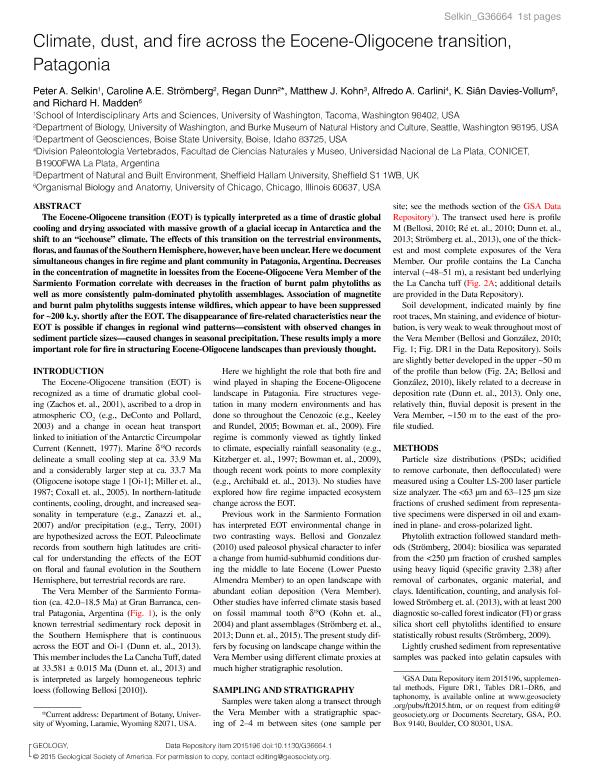Mostrar el registro sencillo del ítem
dc.contributor.author
Selking, Peter A.
dc.contributor.author
Stromberg, Caroline

dc.contributor.author
Dunn, Regan
dc.contributor.author
Khon, Matthew J.
dc.contributor.author
Carlini, Alfredo Armando

dc.contributor.author
Davies-Vollum, K. Siân
dc.contributor.author
Madden, Richard H.
dc.date.available
2019-06-14T18:18:41Z
dc.date.issued
2015-05
dc.identifier.citation
Selking, Peter A.; Stromberg, Caroline; Dunn, Regan; Khon, Matthew J.; Carlini, Alfredo Armando; et al.; Climate, dust, and fire across the Eocene-Oligocene transition, Patagonia; Geological Society of America; Geology; 43; 7; 5-2015; 567-570
dc.identifier.issn
0091-7613
dc.identifier.uri
http://hdl.handle.net/11336/78364
dc.description.abstract
The Eocene-Oligocene transition (EOT) is typically interpreted as a time of drastic global cooling and drying associated with massive growth of a glacial icecap in Antarctica and the shift to an "icehouse" climate. The effects of this transition on the terrestrial environments, floras, and faunas of the Southern Hemisphere, however, have been unclear. Here we document simultaneous changes in fire regime and plant community in Patagonia, Argentina. Decreases in the concentration of magnetite in loessites from the Eocene-Oligocene Vera Member of the Sarmiento Formation correlate with decreases in the fraction of burnt palm phytoliths as well as more consistently palm-dominated phytolith assemblages. Association of magnetite and burnt palm phytoliths suggests intense wildfires, which appear to have been suppressed for ~200 k.y. shortly after the EOT. The disappearance of fire-related characteristics near the EOT is possible if changes in regional wind patterns-consistent with observed changes in sediment particle sizes-caused changes in seasonal precipitation. These results imply a more important role for fire in structuring Eocene-Oligocene landscapes than previously thought.
dc.format
application/pdf
dc.language.iso
eng
dc.publisher
Geological Society of America

dc.rights
info:eu-repo/semantics/openAccess
dc.rights.uri
https://creativecommons.org/licenses/by-nc-sa/2.5/ar/
dc.subject
Paleo Climate
dc.subject
Dust
dc.subject
Eot
dc.subject
Patagonia
dc.subject.classification
Meteorología y Ciencias Atmosféricas

dc.subject.classification
Ciencias de la Tierra y relacionadas con el Medio Ambiente

dc.subject.classification
CIENCIAS NATURALES Y EXACTAS

dc.title
Climate, dust, and fire across the Eocene-Oligocene transition, Patagonia
dc.type
info:eu-repo/semantics/article
dc.type
info:ar-repo/semantics/artículo
dc.type
info:eu-repo/semantics/publishedVersion
dc.date.updated
2019-06-11T15:17:31Z
dc.journal.volume
43
dc.journal.number
7
dc.journal.pagination
567-570
dc.journal.pais
Estados Unidos

dc.journal.ciudad
Boulder
dc.description.fil
Fil: Selking, Peter A.. University of Washington; Estados Unidos
dc.description.fil
Fil: Stromberg, Caroline. University of Washington; Estados Unidos. Burke Museum of Natural History and Culture; Estados Unidos
dc.description.fil
Fil: Dunn, Regan. University of Washington; Estados Unidos. Burke Museum of Natural History and Culture; Estados Unidos
dc.description.fil
Fil: Khon, Matthew J.. Boise State University; Estados Unidos
dc.description.fil
Fil: Carlini, Alfredo Armando. Consejo Nacional de Investigaciones Científicas y Técnicas. Centro Científico Tecnológico Conicet - La Plata; Argentina. Universidad Nacional de La Plata. Facultad de Ciencias Naturales y Museo. División Paleontología Vertebrados; Argentina
dc.description.fil
Fil: Davies-Vollum, K. Siân. Sheffield Hallam University; Estados Unidos
dc.description.fil
Fil: Madden, Richard H.. University of Chicago; Estados Unidos
dc.journal.title
Geology

dc.relation.alternativeid
info:eu-repo/semantics/altIdentifier/doi/http://dx.doi.org/10.1130/G36664.1
dc.relation.alternativeid
info:eu-repo/semantics/altIdentifier/url/https://pubs.geoscienceworld.org/gsa/geology/article/43/7/567/131882/Climate-dust-and-fire-across-the-EoceneOligocene
Archivos asociados
